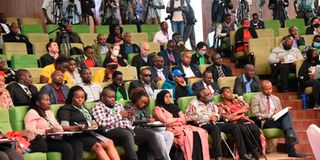Storm over IEBC tech dry run failure rate

Stakeholders follow proceedings at Bomas of Kenya during the testing and simulation of the IEBC results transmission system on June 9, 2022.
The civil society is concerned about the electoral agency’s preparedness to conduct the August 9 General Election.
The concerns came after more than half of the polling stations identified for the testing of a new results transmission system (RTS) failed.
Only 1,200 polling stations successfully transmitted data, out of the 2,900 selected for the system’s dry run. The simulation exercise recorded a 59 per cent failure rate, further fuelling doubts on the Independent Electoral and Boundaries Commission’s (IEBC) readiness to conduct the next elections, which are only 53 days away.
Under the Angaza Movement, 11 civic groups, including ICJ-Kenya, Informaction, Inuka-Kenya and Journalists for Kenya, said the test that was conducted in more than 1,450 wards across the country was a pointer that the IEBC would face serious challenges in making real-time provisional election data accessible to the media and other stakeholders.
“Without good performance for both load testing and stress testing, the IEBC will not know how the RTS will deal with expected or unexpected demands,” said Kenya Human Rights Commission Executive Director Davis Wambua Malombe.
The groups noted that the transmission signal could not be detected in areas such as Silibwet township in Bomet Central.
In Isiolo North Constituency, Lowangila polling stations could also not receive the signal.
In Burat ward, only two out of four centres managed to transmit results.
But in Shambani, the results could be submitted albeit after some delays. The transmission worked well at Akili polling station, which had excellent access to the 3G network.
No hitches were noted in Bonchari, Kisii County, which had eight centres, though only 70 per cent was transmitted from Nyaribari-Masaba.
In Kilgoris constituency, Oltangi, Kilgoris DEB, Osinoni and Sosio polling centres experienced system failures.
In Narok Constituency, Narok town ward experienced transmission failure and extremely slow processing. The observers also noted that no simulation was conducted in Elgeyo-Marakwet County since the KIEMS kits had not yet been delivered.
The Angaza Movement further expressed concern that the simulation exercise was conducted at 2,900 polling stations, a paltry six per cent of the total 46,000 polling stations and that only six satellite phones were tested.
“A successful test would have demonstrated that the IEBC is able to handle a significant load of data at the same time, as will happen on election day. Short of this, the electoral commission is merely ticking a box on a statutory deadline,” they said.
The groups also flagged discrepancies between statements issued in April and June by the IEBC regarding 3G coverage.
They noted that commissioner Francis Wanderi announced that more than 260 polling stations had no 3G coverage, a small figure compared to the 1,111 announced in June by the IEBC.
Transmission system
The groups demanded that the IEBC should list all polling stations without 3G or 4G coverage as well as the county centres from where they will transmit their results.
“The results transmission system may only partially work or collapse on election day,” they said.
They also took issue with a proposal by Commissioner Abdi Guliye that presiding officers be tasked to take physical copies of the results to the national tallying centre at Bomas of Kenya.
They said Mr Guliye’s proposal countermanded the High Court’s decision that results announced at the constituency level are final.
“With more than 50,000 polling stations and some 55 days to go, the IEBC has a small opportunity to ensure there will be no system failure and that all data from all polling stations will be transmitted electronically,” the lobby groups said.
The Angaza Movement demanded that the IEBC should give the public a report on the gaps that led to the system failures and how it intends to fix them.
More specifically, the movement wants the IEBC to publicly name and provide the geolocation coordinates of all 47,000 or so polling stations that will be involved in the general election.
They further want the IEBC to conduct at least one more publicly accessible performance test on its technology, including satellite phones, load testing and stress testing before the elections.
The electoral agency should also commit to the centrality of a well-functioning Kiems network to the electronic transmission of results, the groups added.
The groups also sought clarity on the status of 1,553 satellite phones that were procured in 2017, some 553 units of which arrived after the general election.
They also want to know whether the polls agency bought new satellite phones and modems as well as whether the IEBC will have an online portal where poll results would be live-streamed.
“There are justifiable concerns about the verifiability of the elections in the absence of immediately accessible results, with separately streamed images and numbers acting as a check on each other,” Angaza Movement leader Betty Okero said.
“Kenyans remain the users of the system and the IEBC is running an election for the 22 million-plus registered voters. The IEBC owes them integrity, accountability, transparency and credibility,” she concluded.





